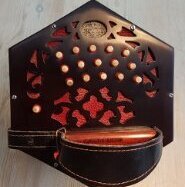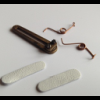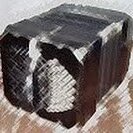
ttonon
Members-
Posts
379 -
Joined
-
Last visited
Contact Methods
-
Website URL
http://www.bluesbox.biz
-
ICQ
0
Profile Information
-
Gender
Male
-
Interests
Many
-
Location
Princeton Junction, New Jersey, USA
Recent Profile Visitors
1,987 profile views
ttonon's Achievements

Chatty concertinist (4/6)
-
Indeed, it seems that's where our society is headed. “The best way to control the opposition is to lead it ourselves.” – Vladimir Lenin I wonder if the societal result stems from this technical ability/conviction. Regards, Tom
- 45 replies
-
- anglo
- electronic
-
(and 2 more)
Tagged with:
-
What "travel" do you mean? It would help if you explain what is travelling and what are the points of the two measurements. Regards, Tom
- 45 replies
-
- anglo
- electronic
-
(and 2 more)
Tagged with:
-
Chris, After all that verbiage, I decided to measure the force I use to play my full size accordion but found that the batteries to my small digital scale are dead. Maybe a reader here could do the measurement for a concertina. It shouldn't be difficult to place a small digital scale between one's palm and push to sound a note to record the force. Press a button the opposite side from the scale, so that the button force doesn't complicate the measurement. Take a number of measurements, with the note barely sounding, to "normal" volume, to maximum volume/force expected in a performance. When I get new batteries, I'll do the same with the accordion.
- 45 replies
-
- anglo
- electronic
-
(and 2 more)
Tagged with:
-
Hi Chris, I think you'd agree that for a reed in an instrument, pressure differential refers to the difference between static pressure inside the bellows where there's little air motion, and that in the outside air, where there's little air motion. In a test rig, it's basically that static pressure difference upstream and downstream of the reed. I'm not sure our findings are contradictory and there may be some differences because I work with the bellows sizes in accordions, and you work with concertinas. (Is your Magnetohelic gauge a Dwyer?) I don't doubt your starting pressures at a couple of tenths of an inch WC and tuning at about 2 inches or above seems okay, though from my experience, your tuning pressure of 1.6-inch WC may be on the low side. That corresponds to a force on the concertina bellows of only 2 pounds (see below). But if concertina players usually play at bellows pressures less than full-size accordion players, it may be representative. The pitch of a free reed is a function of driving pressure, but since most people cannot perceive a change of several cents in actual playing, all the refinements here may not mean much. The statement in my post above refers to the maximum pressures encountered during playing. I'm sure different players use different pressure maximums, but in order to utilize the full dynamic range of a free reed, there can't be too much difference. That assumes that concertina reeds and accordion reeds have similar dynamic properties. Also, my consideration of what is maximum is for when I do calculations on my theoretical fluid dynamical model of free reed vibration. So it may be a bit too large compared to the vast majority of actual performance. I've been away from that project for a couple of years, and when I get back to it, I'll review all this. The typical full-size accordion has internal bellows dimensions of about 6.5 x 17.5 inches^2 and let me guess that for a concertina they are more like 6 x 6, for a cross-sectional area ratio of about three. For a 6-inch WC bellows pressure, the accordion player exerts about 25 pounds force on the bellows, and this is certainly a maximum, but I don't doubt that some beefy players do it momentarily. And that pressure is easier to achieve with the smaller melodians. The area difference means the concertina player needs exert about 1/3 the force or only about 8 pounds for the 6 inch WC. I don't understand. Were you powering the bellows with your arms, or were you supplying the air with a fan? If the latter, I'd guess that you need a stronger fan. If the former, I'm surprised that you couldn't easily maintain a constant pressure when pushing the button. Best regards, Tom
- 45 replies
-
- anglo
- electronic
-
(and 2 more)
Tagged with:
-
I don't know why you would have such suspicions. As an engineer who worked with many different pressure transducers, I know there are many available with much more accuracy than you'd need with response times in the ms. For instance, here's one that's less than $100: https://www.omega.com/en-us/pressure-measurement/pressure-transducers/series-616kd/p/616KD-53 This is a differential transducer with a range -10 to +10 inches of water, ideally suited for typical concertina operation. Pressure transducers have been available for many decades and there are certainly some that can handle this application. Regards, Tom
- 45 replies
-
- anglo
- electronic
-
(and 2 more)
Tagged with:
-
Pros and Cons of Midi Concertinas
ttonon replied to Paul_Hardy's topic in General Concertina Discussion
Rat, impressive instrument, and your playing is very tasteful, pleasing. Am I correct to assume that the load cell has + and - values so that you get two different notes on the same key, depending whether you push or pull. Do the sampled sounds contain the start transient of the note, and are their durations the full sounding time you can get with one bellows direction? Regards, Tom -
Weary, do you use two identities in posting to this group, rgammage and wearyhacker?
- 45 replies
-
- anglo
- electronic
-
(and 2 more)
Tagged with:
-
Richard, thanks for asking the same question I asked, though in more detail. When Weary didn't answer after I asked twice, I gave up. Weary, in the conventional concertina, the lower frequency notes consume much more airflow than do the higher frequency notes. I'm not sure you understand the basic physics here. If you can devise the right questions you need to gain that understanding, please ask me, and I will gladly explain. Regards, Tom
- 45 replies
-
- anglo
- electronic
-
(and 2 more)
Tagged with:
-
Pros and Cons of Midi Concertinas
ttonon replied to Paul_Hardy's topic in General Concertina Discussion
That's all I wanted to hear. Thanks. I had assumed that you store in memory only the developed steady state sound, but as I ponder, I can understand why it would require so much memory. The steady state sound, being independent of time, would require the information of only a Fourier series. How much memory, by the way, per note? Also, how long a time span of the note is stored? Is the time span the same for each note? Then, when you keep playing the note for an extended time, how is the waveform continued beyond the time period you have stored? Regards, Tom -
Pros and Cons of Midi Concertinas
ttonon replied to Paul_Hardy's topic in General Concertina Discussion
By "reed" do you mean a traditional acoustic vibrating reed? I don't think so because there aren't any in your digital instrument. Correct? Could you use the term "key" instead of "reed?" And is the latency the same for all keys? Regards, Tom -
Pros and Cons of Midi Concertinas
ttonon replied to Paul_Hardy's topic in General Concertina Discussion
I'm confused. In your first paragraph you talk about the delay in the digital instrument, but the quote above, citing "low reed startup time," seems to describe the acoustic instrument. Are you saying that in the digital instrument, the low frequency tones and the high frequency tones will have different delay times? -
Pros and Cons of Midi Concertinas
ttonon replied to Paul_Hardy's topic in General Concertina Discussion
How do you define latency, the software/calculation delay between the closure of the key switch to the time the electrical signal is sent to the speaker? Do you have an idea how long of a transient there is between the time the speaker gets the signal and for the acoustic sound to reach a steady state condition? I'm sure it depends on the pitch of the tone. Then there's the time it takes for the sound to reach our ears from the speaker. Of course, our ears/brain don't wait for the speaker to establish the full steady state vibration before we perceive the sound. Even when the transient in the speaker is still going on, we hear something and may not be able to distinguish it that well from the developed steady state sound. But if our interest is in how well the digital instrument compares to the acoustic instrument, and from the delay times I see here, I don't think there would be a problem with the longest delays. That's my guess because the acoustic free reed also has a relatively long start transient, compared to most other instruments; though during most of the transient, there are some sounds. But the long transient was one reason why free reed organ pipes were not as popular as the conventional pipes, at least at some point in pipe organ development. The start transient for acoustic free reeds can be anywhere from about 10 ms up to maybe 50 ms and greater for the lowest notes. The start transient, whether electronic or acoustic, is important in musical tones. In fact, without hearing the start of their tones, we often have trouble distinguishing among different instruments. An interesting experiment to do with the digital instruments with the shortest delays is to play the same key repeatedly as fast as possible. I wonder if some people might have difficulty in discerning separate notes. That may be if the start transient of the notes is small enough. The listener then hears mostly the developed tone and if the gap between tones is small enough, it all might sound like a continuous tone. Regards, Tom -
Pros and Cons of Midi Concertinas
ttonon replied to Paul_Hardy's topic in General Concertina Discussion
Here are videos of a digitized version of the two-row melodeon, a favorite instrument in Basque. The inventor is very competently playing his own invention: https://www.soinutxiki.eus/p/english.html?m=1 I understand that this instrument has no volume control. Tom






